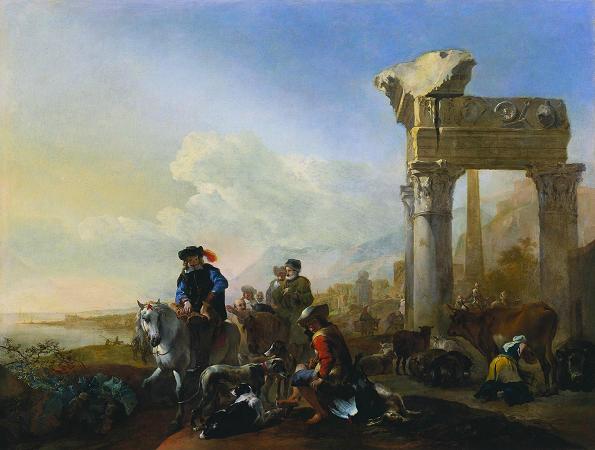Jan Weenix (1641 - 1719). Jan Weenix or Joannis Wenix was a Dutch painter. He was trained by his father, Jan Baptist Weenix, together with his cousin Melchior d'Hondecoeter. Like his father, he painted various subjects, but is mostly known for his paintings of dead game and hunting scenes. Many paintings in this genre were formerly ascribed to the elder Weenix, but are now generally considered to be the work of the son. The Binnen Amstel, Weenix lived at the waterfront behind the house in the middle. Jan Weenix was born in Amsterdam according to his notice of marriage in 1679 but his date of birth is not exactly known as the baptismal record of this catholic church did not survive. Between 1643 and 1647 his father worked in Italy, but the family moved to Utrecht around 1649. His father subsequently moved into a castle near Vleuten, but died rather young in 1659. By the age of twenty Jan Weenix rivalled and later surpassed his father in breadth of treatment and richness of colour. Jan Weenix was a member of the Utrecht guild of painters in 1664 and 1668. Marriage and children In 1679, Jan Weenix married the 20-year-old Pieternella Backers. Between 1680 and 1700, the couple had 13 children who were baptized in a hidden church. At least four were sons-Jan Baptista, Willem Ignatius, Jacobus, Nicolaes Andreas-and two were daughters: Sara and Maria Weenix. In 1697 he painted a portrait of Peter the Great, visiting the Republic to study shipbuilding, science, and the art of fortification building. In Amsterdam, Weenix was frequently employed to decorate private houses with wall-paintings on canvas. He painted five fixed paintings or wallpaper on canvas for Jacob de Granada; these became very popular in the second half of the 18th century when nature and Rousseau were fashionable and copied. The paintings survived in the house until 1922. Then the enormous paintings were sold before an auction to William Randolph Hearst in a private arrangement. After Hearst went bankrupt, the paintings were dispersed; one is in the National Galleries of Scotland in Edinburgh, two are in the Hotel Carlyle in New York, one has been in the Allen Memorial Art Museum since 1953 and one is lost. Between 1702 and 1712 Weenix was occupied with an important series of twelve large hunting pictures for the Elector Palatine Johann Wilhelm's castle of Bensberg, near Cologne. Also Eglon van der Neer, Rachel Ruysch, Adriaen van der Werff had a very good relationship with the court, being paid well or knighted as ridder and probably meeting an international crowd of artists and musicians. The treasury was empty when Jan Wellem, as he was called in Dusseldorf, died. Most of this collection is now at the Munich Gallery. Weenix' pupils were his daughter Maria Weenix and Dirk Valkenburg.Jan Weenix lived most of his life in a house across the Mint Tower and was buried in Nieuwezijds Kapel a nearby catholic church on the Rokin. His widow and daughters stayed in the masonry business, selling stones and tiles. Johann Wolfgang von Goethe was impressed by the treatment of animals in Weenix pictures which he saw in Munich. He devoted a poem to Weenix's technique, in which he stated that Weenix equaled and even surpassed nature in his treatment of animal textures such as hair, feathers and claws. Many of his best works are to be found in English private collections. The National Gallery, London has two paintings, including A Deerhound with Dead Game and Implements of the Chase, while the Wallace Collection has thirteen paintings, including Flowers on a Fountain with a Peacock. Outside the United Kingdom, Jan Weenix is well represented in the galleries of Amsterdam, The Hague, Haarlem, Rotterdam, Berlin, Lisbon and Paris.
more...













